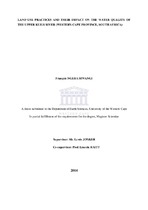| dc.contributor.advisor | Jonker, Lewis | |
| dc.contributor.advisor | Raitt, Lincoln | |
| dc.contributor.author | Mwangi, François Ngera | |
| dc.date.accessioned | 2014-06-18T13:59:23Z | |
| dc.date.available | 2014-06-18T13:59:23Z | |
| dc.date.issued | 2014 | |
| dc.identifier.uri | http://hdl.handle.net/11394/3366 | |
| dc.description | >Magister Scientiae - MSc | en_US |
| dc.description.abstract | The water quality in many Cape Town Rivers and streams is a major challenge. Kuils River is subject to multiple land use impacts from upstream to downstream because of rapid urbanization in its catchment area. The main pollution sources are urban and industrial, organic matter from litter under the road-bridge, and golf course. However no systematic efforts have been made to evaluate and improve the health of the river
in term of management. To assess impacts on water quality, this study was conducted from 4th September to 27th November 2012 in 5 selected sites in the upper reach of the Kuils river. The main aim was to compare the health of the river in 2012 with that found in 2005 using physical and chemical characteristics and the South Africa Scoring System (SASS). The statistical analysis showed a significant difference between and within sites. The water temperature, pH, dissolved oxygen concentration, total dissolved solids (TDS), and salinity were collected in situ by YSI 30 meter. To evaluate nutrient (nitrate and phosphorus) concentrations water samples were analyzed at UWC laboratory using spectrophotometer. In addition human activities, basic conditions (7.13 to 8.76), high total dissolved solids (416 to to 916.5 mg L¯¹) and salinity (0.31 to 0.71 mg L¯¹) concentrations were influenced by Malmesbury shales. Nitrate (0.1 to 3.1 mg L¯¹) and phosphorus (0.11 to 5.27 mg L¯¹) concentrations and the decrease in dissolved oxygen in November 2012 showed eutrophic conditions of the river. In the tributary site phosphorus (1.32 to 3.62 mg L¯¹) concentrations revealed hypertrophic condition compared to South Africa guideline. Macroinvertebrates sampled showed a total of 28 taxa grouped in 11 orders were sampled. Poor habitat diversity and water quality degradation were principal causes of low species diversity. The South Africa Score System version 5 (SASS5) and Average Score per Taxon (ASPT) indicated that the river is seriously impacted in 2012 compared to 2005 where water quality was in poor condition. The SASS and the ASPT scores were less than 50 and 4.2 at all
sampling sites in most part of sampling period. | en_US |
| dc.language.iso | en | en_US |
| dc.publisher | University of Western Cape | en_US |
| dc.subject | Land use | en_US |
| dc.subject | Water quality | en_US |
| dc.subject | Upper Kuils River | en_US |
| dc.subject | Physical and chemical parameters | en_US |
| dc.subject | Nitrate | en_US |
| dc.subject | Phosphate | en_US |
| dc.subject | Macroinvertebrates | en_US |
| dc.subject | South African Scoring System version 5 (SASS5) | en_US |
| dc.subject | Ecological state of the river | en_US |
| dc.title | Land use practices and their impact on the water quality of the Upper Kuils River (Western Cape Province, South Africa) | en_US |
| dc.type | Thesis | en_US |
| dc.rights.holder | University of Western Cape | en_US |

